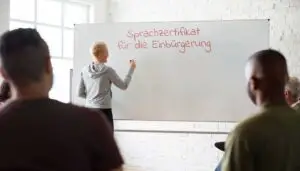According to an answer from the Federal Ministry of the Interior to a question from the Left Party, which was reported by the Rheinische Post, among others, the Federal Ministry of Finance has already approved the additional expenditure.
This secures funding for integration courses in the current year - and gives both providers and participants planning security.
High demand for refugees from Ukraine and Syria
The demand for integration courses remains high: according to media reports, around 122,800 people have already taken part in a course in the first four months of 2025 alone.
If the trend continues, this will mean a total of over 360,000 migrants in 2025 - a similar number to the previous year. As in previous years, people with Ukrainian citizenship make up the largest group of participants, followed by migrants from Syria and Afghanistan.
In 2024, the German government already provided over one billion euros for integration courses. During the coronavirus pandemic in 2021/2022, expenditure was still less than 500 million euros.

According to § 10 paragraph 1 sentence 7 StAG, the naturalization test certificate is a central proof of successful participation in the naturalization test. This certificate is not only proof that you have the necessary knowledge of the legal and social order as well as the living conditions in Germany.
Integration courses part of German integration policy since 2005
Since the introduction of integration courses with the Immigration Act in 2005, they have become a central component of integration policy in Germany. Today, they are part of the overall language program, which was expanded in 2016 to include vocational language courses.
The course formats are constantly being developed further - with a clear focus on everyday communication, practical application and an increased focus on digital learning opportunities. The Common European Framework of Reference for Languages (CEFR) serves as the basis for the quality standards.
What does an integration course in Germany involve - how long does it last?
An integration course in Germany consists of:
- a language course
- an orientation course
The general integration course usually comprises 700 to 1000 teaching units (TU). Participants with good learning prerequisites have the option of completing the course as an intensive course with 500 teaching units.
Depending on your personal situation, the course can be attended full-time or part-time. Part-time courses - for example in the afternoon or evening - are primarily aimed at working people or people with family commitments.
What does the language course include?
The language course lasts between 600 and 900 teaching units in the general integration course and 400 units in the intensive course. Central topics from everyday German life are covered:
- Work and profession
- Training and further education
- Care and education of children
- Shopping, trade and consumption
- Leisure and social contacts
- Health and hygiene
- Media and media use
- Living
- Practical communication: writing letters and e-mails, filling out forms, making phone calls, writing job applications
At the end there is the "German Test for Immigrants (DTZ)" exam.
What does the orientation course involve?
After completing the language course, the orientation course follows , which usually comprises 100 teaching units. This deals with basic social and political knowledge:
- German legal system, history and culture
- Rights and obligations in Germany
- Forms of coexistence in society
- Values that are important in Germany, for example religious freedom, tolerance and equal rights for women and men
The orientation course concludes with the final test "Living in Germany".
Who can take part in the integration course?
Entitled to participate according to §44 AufenthG are:
- Late repatriates and new immigrants with permanent Residence permit
- EU citizens
- Migrants who have already been living in Germany for some time
- Germans in particularneed of integration
- Asylum seekers and tolerated persons with a residence permit in accordance with Section 60a (2) sentence 3 AufenthG
- Holders of a residence permit according to § 24 or 25 para. 5 AufenthG
- Holders of a residence permit in accordance with § 104c AufenthG (right of residence by opportunity).
Who must take part in an integration course?
In certain cases, the Foreigners' office or another authority may oblige you to attend an integration course in accordance with §44a AufenthG. This happens, for example, in the case of
- new immigrants who cannot communicate orallyin German in a simple way
- Foreigners who have been living in Germany for some time and who areparticularly in need of integration
- Asylum seekers, tolerated persons with a residence permit in accordance with Section 60a (2) sentence 3 AufenthG and holders of a residence permit in accordance with Section 25 (5) AufenthG who receive benefits in accordance with the Asylum Seekers Benefits Act and who are requested by the responsible office to participate in an integration course
In principle, half of the costs are borne by the participant and the other half by the state. Currently, the cost contribution for migrants is 2.29 euros per lesson. In cases of social hardship, an application for cost exemption can be made.
Conclusion: An integration course in Germany is worthwhile
We at Migrando recommend that all immigrants take part in an integration course. The courses are not only an important step towards getting to know the German language and society better, but are also of great importance for long-term prospects in Germany.
Because proof of sufficient language skills (B1 level) and integration knowledge ("Living in Germany" test) is mandatory if you wish to be naturalized in Germany in the future or apply for a Settlement permit .










